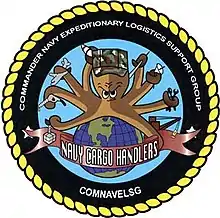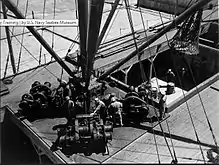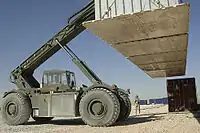Navy Expeditionary Logistics Support Group (United States)
Navy Expeditionary Logistics Support Group (NAVELSG) is an echelon IV command in the United States Navy and part of Navy Expeditionary Combat Command (NECC).
| Navy Expeditionary Logistics Support Group | |
|---|---|
 COMNAVELSG Seal | |
| Active | 1993 – present |
| Country | United States |
| Allegiance | |
| Branch | |
| Type | Navy Expeditionary Combat Force |
| Role | Rapid response logistics |
| Size | 2,900 |
| Garrison/HQ | Naval Weapons Station Yorktown, Cheatham Annex |
| Motto(s) | "Anytime, Anywhere" |
| Commanders | |
| Commander, NAVELSG | RDML Jacquelyn McClelland[1] |
Mission
Navy Expeditionary Logistics Support Group (NAVELSG) is a vital enabler of Maritime Prepositioning Forces (MPF), Joint Logistics Over The Shore (JLOTS) operations, and maritime forces ashore providing expeditionary cargo handling services for surface, air, and terminal operations, tactical fueling, and ordnance handling/reporting in support of worldwide Naval, Joint, interagency, and combined forces/organization.
NAVELSG is responsible for providing expeditionary logistic capabilities for the Navy, primarily within the maritime domain of the littorals, and conducts surface and air cargo handling missions, cargo terminal and warehouse operations, fuels distribution, postal services, customs inspections, ordnance reporting and handling, and expeditionary communications.
NAVELSG is an "Operational Reserve" command organized and staffed to provide a wide range of supply and transportation support critical for peacetime support, crisis response, humanitarian and combat service support missions.
NAVELSG delivers logistics capabilities with active and mobilization-ready Navy Reserve Force Sailors and equipment to theater commanders in support of the military strategy:
• Organizes, trains, equips and deploys active and reserve units for port and air cargo handling missions, ordnance handling and reporting services, and supply support to forces deployed ashore.
• Responds to humanitarian relief efforts and builds allies through humanitarian efforts among host nations.
Background


To most Americans, Williamsburg, Virginia, is known as the Colonial Capital. To the "Combat Stevedores" of the Navy, Williamsburg – or more precisely, Naval Weapons Station Yorktown – Cheatham Annex – is known as the capital of Navy expeditionary logistics. The U.S. Navy's first "Combat Stevedores" were the 41 Special Naval Construction Battalions of the Seabees, created during WWII.[2] Their primary function was stevedoring often in combat situations, 15 of which were segregated units. The men received the standard mix of USN/USMC training that Seabees received. After which they went through stevedore schools with complete mock ships built on dry land at the Seabee training centers. By 1945 they were some of the Navy's first fully integrated units. The end of the war brought the decommissioning of all 41 battalions.
Of note were the actions of the 17th Special(segregated) at Peleliu 15-18 Sept 1944. The Japanese mounted a counter-attack 0200 D-day nite. By the time it was over nearly the entire 17th had volunteered to carry ammunition to the front lines, bring wounded back, fill where needed on the line and man 37mm that had lost their crews. C Co 1st Battalion 7th Marines was hit hardest that night and was very much in need of the 17ths support. The 17th remained with the 7th Marines until the right flank had been secured D-plus3.[3][4][5][6][7]
Navy Cargo Handling Battalion ONE (NCHB 1) was commissioned 1 October 1949 and was organized after the Special Construction Battalions of World War II.[8] In 1956 the battalion was an element of Operation Deep Freeze and has deployed there numerous times since.[8]
In 1965 "the Cargo Handling Battalions from Yorktown, VA (commanded by CDR John Hatfield, SC, USN) and from Subic Bay, PI (commanded by LCDR Hugo Luoto, SC, USN) were deployed to augment Task Group 76.4 in the actual discharge of ships' cargo" for I Corps (South Vietnam) of the III Marine Amphibious Force".[9]
More recently, the lessons learned from Operation Desert Storm identified a requirement for a single, multifunctional organization able to provide flexible, deployable transportation and supply support logistics services in any area of the world. Established in 1993, the Naval Expeditionary Logistics Support Group (NAVELSG) was built upon the foundation of the Navy Cargo Handling Force (NCHF). The NCHF originated in the 1970s with the establishment of six Reserve Navy Cargo Handling Battalions to support the Marine Corps Maritime Prepositioning Force. The number of battalions grew to 12 in the 1980s.

Capabilities include warehouse and freight terminal management, fuel distribution, tent camp, maintenance and personnel support functions, mail distribution and barbershop, laundry and ship's store to traditional shipboard cargo handling and expeditionary air cargo operations. The NAVELSG mission is to provide transportation (cargo handling) and supply Advanced Base Functional Component support to Navy and Marine Corps operational units. NAVELSG is recognized by all major commanders as the force of choice for transportation and supply professionals, trained and equipped to deploy anywhere in the world and provide effective shore-based logistical support to naval operating forces – "Anytime, Anywhere".
NAVELSG (Echelon IV), directs four Navy Expeditionary Logistics Regiments (NELR) (Echelon V) and their subordinate Navy Cargo Handling Battalions (NCHBs)(Echelon VI) each battalion composed of one Headquarters Company, four Surface Companies, one Air Cargo Company, two Cargo Transfer Companies, one Fuels Company and two Expeditionary Support Companies. Additionally, each NELR has an Expeditionary Communications Detachment (ECD).
Subordinate Units
- Navy Expeditionary Logistics Support Group Forward (NAVELSG FWD), CTG 56.3, NSA Bahrain, Bahrain
- First Navy Expeditionary Logistics Regiment (1ST NELR), Cheatham Annex
- NCHB 1: The only active duty cargo handling unit, based at Cheatham Annex, Naval Weapons Station Yorktown, Virginia.
- ECD 1: Joint Base Andrews, MD
- Second Navy Expeditionary Logistics Regiment (2ND NELR), Cheatham Annex
- NCHB 8: Fort Dix, Lakehurst, NJ
- NCHB 10: Yorktown Naval Weapons Station, Yorktown, VA
- ECD 2: Cheatham Annex, Williamsburg, VA
- Fourth Navy Expeditionary Logistics Regiment (4TH NELR), Jacksonville, FL
- NCHB 11: Jacksonville, FL
- NCHB 13: Gulfport, MS
- Fifth Navy Expeditionary Logistics Regiment (5TH NELR), Point Mugu, CA
- NCHB 5: Joint Base Lewis McChord, Tacoma, WA
- NCHB 14: Port Hueneme, CA
- ECD 5: North Is NAS, Coronado, CA
References
- http://www.public.navy.mil/necc/navelsg/Pages/cobio.aspx
- Special Naval Construction Battalion Cruisebooks,NHHC, U.S. Navy Seabee Museum webpage
- "17th Special NCB cruisebook" (PDF). Naval History and Heritage Command. p. 29. Retrieved 18 October 2017.
- "Seabees of 17th Special Naval Construction Battalion Wait to Assist Wounded of 7th Marines". World War II Database. Retrieved 18 October 2017.
- "African-American Marines of 16th Field Depot Rest on Peleliu". World War II Database. Retrieved 18 October 2017.
- "17 Special Naval Construction Battalion" (PDF). Naval History and Heritage Command. Retrieved 18 October 2017.
- Princeton University Library, Marine Corps Chevron, Vol 3 Number 48, 2 December 1944
- NCHB1 Command web-page
- Story of DaNang.pages - Class of 1957 webpage, Some recollections of DaNang, US Navy Supply Corps